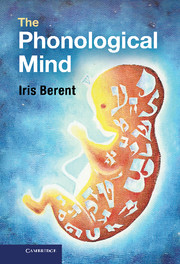Book contents
- Frontmatter
- Contents
- Figures
- Tables
- Copyright acknowledgements
- Preface
- Part I Introduction
- Part II Algebraic phonology
- 4 How phonological categories are represented
- 5 How phonological patterns are assembled
- Part III Universal design
- Part IV Ontogeny, phylogeny, phonological hardware, and technology
- References
- Index
5 - How phonological patterns are assembled
the role of algebraic variables in phonology
Published online by Cambridge University Press: 05 February 2013
- Frontmatter
- Contents
- Figures
- Tables
- Copyright acknowledgements
- Preface
- Part I Introduction
- Part II Algebraic phonology
- 4 How phonological categories are represented
- 5 How phonological patterns are assembled
- Part III Universal design
- Part IV Ontogeny, phylogeny, phonological hardware, and technology
- References
- Index
Summary
Chapter 5 further investigates the scope of phonological categories and the principles governing their combinations. Specifically, I examine whether phonological patterns encode relations among variables – the hallmark of powerful algebraic systems capable of generating discrete infinity. To this end, I systematically gauge the scope of phonological generalizations using a single case study taken from Hebrew. Hebrew manifests an interesting restriction on the location of identical consonants. It allows stems such as simem (with identical consonants at the right edge), but disallows forms like sisem (with identical consonant at the left edge). Remarkably, Hebrew speakers freely extend this generalization not only to any native consonant (thereby providing further evidence that consonants form an equivalence class) but also to novel ones, including novel consonants with novel features. Such generalizations, as I next show, are only attainable by computational devices that operate on variables. Accordingly, the documentation of such generalizations in Hebrew demonstrates that the phonological grammar is an algebraic system endowed with the capacity for across-the-board generalizations, comparable to syntactic generalizations. But while algebraic machinery is clearly necessary to account for phonological generalizations, further evidence suggests it is not sufficient. A full account of phonological generalizations thus requires a dual-route model, equipped with an algebraic grammar and an associative lexical system.
How do phonological categories combine to form patterns?
All patterns comprise building blocks, assembled according to some combinatorial principles. Chapter 4 suggested that the building blocks of phonological patterns are abstract categories that form equivalence classes. The equivalence of category members is significant because it supports broad generalizations of phonological knowledge. Specifically, if all instances of a category are treated alike, then knowledge concerning the category will automatically extend to new members. But while the findings reviewed so far strongly suggest that some phonological categories are equivalence classes, the classes we had considered were not only finite but also quite small. This limitation raises the question of whether the phonological grammar does, in fact, support open-ended generalizations, known as the capacity for “discrete infinity” (Chomsky, 1972).
- Type
- Chapter
- Information
- The Phonological Mind , pp. 84 - 114Publisher: Cambridge University PressPrint publication year: 2013

